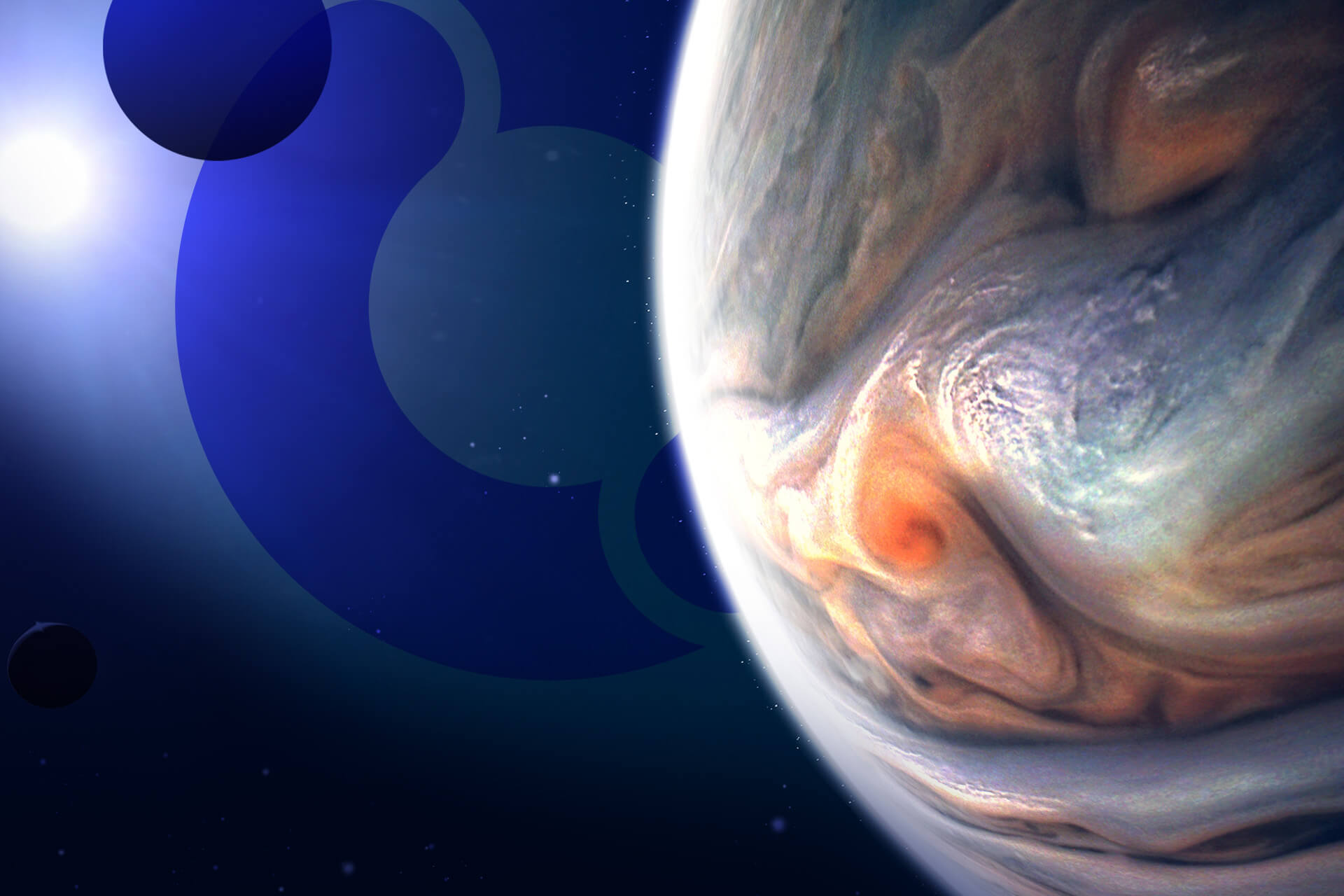



Revolutionized is reader-supported. When you buy through links on our site, we may earn an affiliate commision. Learn more here.
Jupiter is a massive gas giant that’s the first of the outer planets and one of the last that we can spot from the surface of our little blue marble known as Earth. Here are some interesting facts about Jupiter that you need to know.
Here are 10 interesting planet Jupiter facts to know about this giant celestial being.
Jupiter gets its name from the king of the Roman gods, also known as Zeus in Greek mythology. One of our probes currently sending back pictures of the gas giant is named Juno after Jupiter’s wife.
You can combine all the other planets in the solar system, and Jupiter is still 2.5 times more massive than all of them.
Of all the planet Jupiter facts, this one is a doozy. The planet is enormous, but if it got any bigger, the additional mass would cause it to start collapsing in on itself. It would take a lot of extra weight to make it get smaller than it is now. Scientists estimate that it could quadruple its mass and remain the same size.
One Jovian mass equals the mass of the planet Jupiter or 2.5 times the rest of the planets in the solar system combined. It’s a standard measurement astronomers can use to describe similarly sized celestial bodies.
Despite what happened in Arthur C. Clarke’s novel “2010: Odyssey Two,” the gas giant doesn’t possess enough mass to ignite and become a second star. It would need to be roughly 80 times more massive than it is to reach that critical ignition point — and we don’t have Clarke’s aliens helping us out.
In 1610, Galileo spotted the first four Jovian moons. It was the first proof of celestial bodies orbiting something other than Earth. It reinforced Copernicus’s model of the solar system, with all of the planets orbiting the sun instead of treating the Earth like the center of the universe.
Its year might take nearly 12 of ours, but Jupiter’s day is only 9 hours and 55 minutes. This is the shortest day in the solar system.
Jupiter has 95 moons and used to hold the title of the planet with the most in the solar system. As of 2023, that title belonged to Saturn, with 146 natural satellites.
Jupiter’s iconic Great Red Spot is a massive storm. It’s so large that you could fit three of our planets inside it and have room to spare. It’s been churning on the Jovian surface for at least 150 years.
While they aren’t as prominent as those around Saturn, Jupiter has some faint rings. They likely consist of captured material ejected when its moons collide with one another.
Io, one of Jupiter’s moons, is the most volcanically active area of our solar system. Scientists have studied it to learn more about tidal heating. They believe that phenomenon plays a key role in how planets form and evolve.
Previous data showed astronomers that Jupiter has active volcanoes at its poles, which may help regulate tidal heating in the planet’s magma interior.
Those researching outer space know the importance of continually pushing the boundaries of what others believe possible. A case in point is NASA’s Europa Clipper mission, dedicated to exploring a subsurface ocean on one of the planet’s moons.
Researchers wonder whether the ocean could support life, and they’ll begin exploring that question once this mission’s spacecraft begins orbiting Jupiter in April 2030.
An anticyclone is a large-scale wind event characterized by circular movement. Jupiter has one called the Great Red Spot. Although scientists have known about and studied it for 150 years, there is always more to learn. One example came in October 2024, when data from the Hubble Space Telescope suggested that the anticyclone is not as stable as it first appeared.
They determined that after noticing its oscillating size, defined by the anticyclone moving in and out as it simultaneously moves faster or slower. The researchers confirmed that was unexpected, and they have yet to pinpoint a reason for that characteristic.
In March 2024, a NASA spacecraft took direct measurements of charged hydrogen and oxygen molecules from Europa, one of Jupiter’s largest moons. Those gave them the first-in-situ data about water components in Europa’s atmosphere. That information allowed concluding that the potential oxygenation of its subsurface ocean would have limited associated parameters.
Additionally, the scientists applied narrow constraints to Europa’s oxygen production, believing it is currently around 12 kilograms per second. However, previous estimates were much larger, ranging from a few kilograms per second to over 1,000. They said their data gives them an unambiguous demonstration of oxygen production on Jupiter’s moon, but that it occurs at a much lower rate than previously thought.
New information such as that is crucial for giving people accurate perceptions of the planet and its activities. Then, scientists can continually adjust what they know.
Some scientists are eager to gather Jupiter information because they realize connections between what happens on the planet and events on Earth. In one example, researchers became interested in Jupiter’s space weather because of how it could affect our power grids or communication satellites. This group made progress by learning more about Jupiter’s magnetosphere.
They confirmed that it has largely closed magnetic fields at its polar regions, but there are crescent-shaped areas of open field lines. They confirmed that it has largely closed magnetic fields at its polar regions, but there are crescent-shaped areas of open field lines. Jupiter is among some other planets with magnetospheres, enabling them to deflect significant amounts of solar wind.
Jupiter is the last planet that is visible to the naked eye from the surface of Earth. This visibility makes it nearly impossible to determine who discovered it. The first recorded mentions of the gas giant belong to the Babylonians, sometime around the seventh or eighth century B.C. Galileo often gets the credit for discovering Jupiter because he was the first to observe its moons, but we’ve been watching the king of the gods for millennia.
Jupiter is the most massive planet in our solar system, and it’s the only gas giant we can see without the assistance of a telescope. Until this year, it also had the most moons of any planet in the solar system, but even if Saturn stole its title, its collection of 79 satellites is still impressive.
There are a few planet Jupiter facts that make this massive gas giant unique. The first is the Great Red Spot, the gigantic storm that’s been raging on the Jovian surface for decades. It also doesn’t have seasons like many other planets because its axis has almost no tilt.
With these facts about Jupiter, you can impress friends at your next quiz night or offer them some tidbits during a relaxing night of hanging out. Planets perpetually fascinate people, and there are plenty of good reasons for that. Pick a few favorite bits of Jupiter information and use them to show your interest in our solar system and its planets.
Featured Image Credit: Nova Dawn Astrophotography / CC BY-SA
Revolutionized is reader-supported. When you buy through links on our site, we may earn an affiliate commision. Learn more here.


This site uses Akismet to reduce spam. Learn how your comment data is processed.